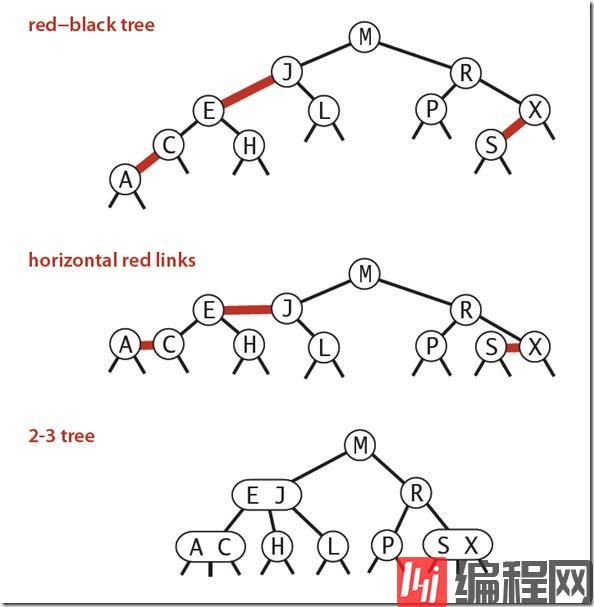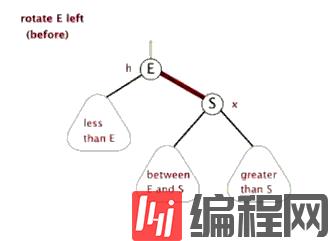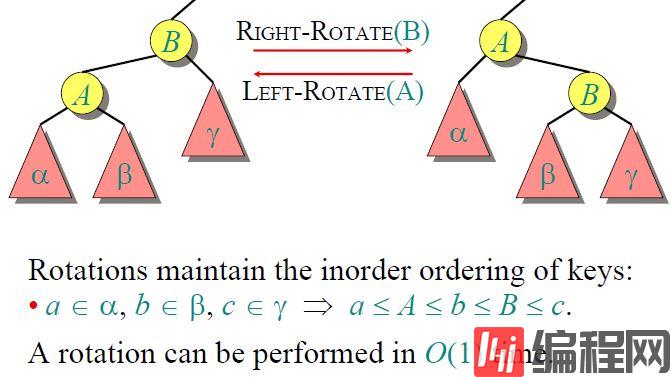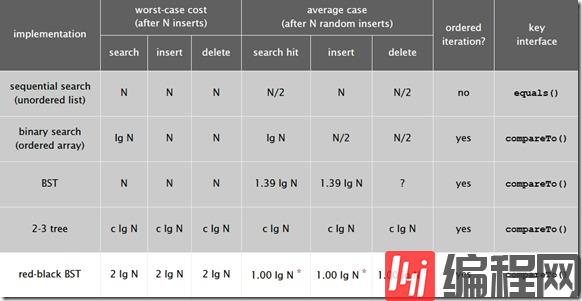这篇文章主要介绍了java算法如何实现红黑树,具有一定借鉴价值,感兴趣的朋友可以参考下,希望大家阅读完这篇文章之后大有收获,下面让小编带着大家一起了解一下。红黑树定义红黑树(英语:Red–black tree)是一种自平衡二叉查找树,是在计
这篇文章主要介绍了java算法如何实现红黑树,具有一定借鉴价值,感兴趣的朋友可以参考下,希望大家阅读完这篇文章之后大有收获,下面让小编带着大家一起了解一下。
红黑树
定义
红黑树(英语:Red–black tree)是一种自平衡二叉查找树,是在计算机科学中用到的一种数据结构,典型的用途是实现关联数组。
红黑树的另一种定义是含有红黑链接并满足下列条件的二叉查找树:
红链接均为左链接;没有任何一个结点同时和两条红链接相连;该树是完美黑色平衡的,即任意空链接到根结点的路径上的黑链接数量相同。
满足这样定义的红黑树和相应的2-3树是一一对应的。

旋转
旋转又分为左旋和右旋。通常左旋操作用于将一个向右倾斜的红色链接旋转为向左链接。对比操作前后,可以看出,该操作实际上是将红线链接的两个节点中的一个较大的节点移动到根节点上。
左旋操作如下图:

右旋旋操作如下图:

即:

复杂度
红黑树的平均高度大约为lgN。
下图是红黑树在各种情况下的时间复杂度,可以看出红黑树是2-3查找树的一种实现,他能保证最坏情况下仍然具有对数的时间复杂度。

Java代码
import java.util.NoSuchElementException;import java.util.Scanner;public class RedBlackBST<key extends="" key="">, Value> { private static final boolean RED = true; private static final boolean BLACK = false; private node root; //root of the BST private class Node { private Key key; //key private Value val; //associated data private Node left, right; //links to left and right subtrees private boolean color; //color of parent link private int size; //subtree count public Node(Key key, Value val, boolean color, int size) { this.key = key; this.val = val; this.color = color; this.size = size; } } //is node x red? private boolean isRed(Node x) { if(x == null) { return false; } return x.color == RED; } //number of node in subtree rooted at x; 0 if x is null private int size(Node x) { if(x == null) { return 0; } return x.size; } public int size() { return size(root); } public boolean isEmpty() { return root == null; } public Value get(Key key) { if(key == null) { throw new NullPointerException("argument to get() is null"); } return get(root, key); } //value associated with the given key in subtree rooted at x; null if no such key private Value get(Node x, Key key) { while(x != null) { int cmp = key.compareTo(x.key); if(cmp < 0) { x = x.left; } else if(cmp > 0) { x = x.right; } else { return x.val; } } return null; } public boolean contains(Key key) { return get(key) != null; } public void put(Key key, Value val) { if (key == null) { throw new NullPointerException("first argument to put() is null"); } if (val == null) { delete(key); return; } root = put(root, key, val); root.color = BLACK; } // insert the key-value pair in the subtree rooted at h private Node put(Node h, Key key, Value val) { if(h == null) { return new Node(key, val, RED, 1); } int cmp = key.compareTo(h.key); if(cmp < 0) { h.left = put(h.left, key, val); } else if(cmp > 0) { h.right = put(h.right, key, val); } else { h.val = val; } if(isRed(h.right) && !isRed(h.left)) { h = rotateLeft(h); } if(isRed(h.left) && isRed(h.left.left)) { h = rotateRight(h); } if(isRed(h.left) && isRed(h.right)) { flipColors(h); } h.size = size(h.left) + size(h.right) + 1; return h; } public void deleteMin() { if (isEmpty()) { throw new NoSuchElementException("BST underflow"); } // if both children of root are black, set root to red if (!isRed(root.left) && !isRed(root.right)) root.color = RED; root = deleteMin(root); if (!isEmpty()) root.color = BLACK; // assert check(); } // delete the key-value pair with the minimum key rooted at h // delete the key-value pair with the minimum key rooted at h private Node deleteMin(Node h) { if (h.left == null){ return null; } if (!isRed(h.left) && !isRed(h.left.left)) { h = moveRedLeft(h); } h.left = deleteMin(h.left); return balance(h); } public void deleteMax() { if (isEmpty()) { throw new NoSuchElementException("BST underflow"); } // if both children of root are black, set root to red if (!isRed(root.left) && !isRed(root.right)) root.color = RED; root = deleteMax(root); if (!isEmpty()) root.color = BLACK; // assert check(); } // delete the key-value pair with the maximum key rooted at h // delete the key-value pair with the maximum key rooted at h private Node deleteMax(Node h) { if (isRed(h.left)) h = rotateRight(h); if (h.right == null) return null; if (!isRed(h.right) && !isRed(h.right.left)) h = moveRedRight(h); h.right = deleteMax(h.right); return balance(h); } public void delete(Key key) { if (key == null) { throw new NullPointerException("argument to delete() is null"); } if (!contains(key)) { return; } //if both children of root are black, set root to red if(!isRed(root.left) && !isRed(root.right)) { root.color = RED; } root = delete(root, key); if(!isEmpty()) { root.color = BLACK; } } // delete the key-value pair with the given key rooted at h // delete the key-value pair with the given key rooted at h private Node delete(Node h, Key key) { if(key.compareTo(h.key) < 0) { if(!isRed(h.left) && !isRed(h.left.left)) { h = moveRedLeft(h); } h.left = delete(h.left, key); } else { if(isRed(h.left)) { h = rotateRight(h); } if (key.compareTo(h.key) == 0 && (h.right == null)) { return null; } if (!isRed(h.right) && !isRed(h.right.left)) { h = moveRedRight(h); } if (key.compareTo(h.key) == 0) { Node x = min(h.right); h.key = x.key; h.val = x.val; h.right = deleteMin(h.right); } else { h.right = delete(h.right, key); } } return balance(h); } // make a left-leaning link lean to the right // make a left-leaning link lean to the right private Node rotateRight(Node h) { // assert (h != null) && isRed(h.left); Node x = h.left; h.left = x.right; x.right = h; x.color = x.right.color; x.right.color = RED; x.size = h.size; h.size = size(h.left) + size(h.right) + 1; return x; } // make a right-leaning link lean to the left // make a right-leaning link lean to the left private Node rotateLeft(Node h) { // assert (h != null) && isRed(h.right); Node x = h.right; h.right = x.left; x.left = h; x.color = x.left.color; x.left.color = RED; x.size = h.size; h.size = size(h.left) + size(h.right) + 1; return x; } // flip the colors of a node and its two children // flip the colors of a node and its two children private void flipColors(Node h) { // h must have opposite color of its two children // assert (h != null) && (h.left != null) && (h.right != null); // assert (!isRed(h) && isRed(h.left) && isRed(h.right)) // || (isRed(h) && !isRed(h.left) && !isRed(h.right)); h.color = !h.color; h.left.color = !h.left.color; h.right.color = !h.right.color; } // Assuming that h is red and both h.left and h.left.left // are black, make h.left or one of its children red. // Assuming that h is red and both h.left and h.left.left // are black, make h.left or one of its children red. private Node moveRedLeft(Node h) { // assert (h != null); // assert isRed(h) && !isRed(h.left) && !isRed(h.left.left); flipColors(h); if (isRed(h.right.left)) { h.right = rotateRight(h.right); h = rotateLeft(h); flipColors(h); } return h; } // Assuming that h is red and both h.right and h.right.left // are black, make h.right or one of its children red. // Assuming that h is red and both h.right and h.right.left // are black, make h.right or one of its children red. private Node moveRedRight(Node h) { // assert (h != null); // assert isRed(h) && !isRed(h.right) && !isRed(h.right.left); flipColors(h); if (isRed(h.left.left)) { h = rotateRight(h); flipColors(h); } return h; } // restore red-black tree invariant // restore red-black tree invariant private Node balance(Node h) { // assert (h != null); if (isRed(h.right)) { h = rotateLeft(h); } if (isRed(h.left) && isRed(h.left.left)) { h = rotateRight(h); } if (isRed(h.left) && isRed(h.right)) { flipColors(h); } h.size = size(h.left) + size(h.right) + 1; return h; } public int height() { return height(root); } private int height(Node x) { if (x == null) { return -1; } return 1 + Math.max(height(x.left), height(x.right)); } public Key min() { if (isEmpty()) { throw new NoSuchElementException("called min() with empty symbol table"); } return min(root).key; } // the smallest key in subtree rooted at x; null if no such key private Node min(Node x) { // assert x != null; if (x.left == null) { return x; } else { return min(x.left); } } public Key max() { if (isEmpty()) { throw new NoSuchElementException("called max() with empty symbol table"); } return max(root).key; } // the largest key in the subtree rooted at x; null if no such key private Node max(Node x) { // assert x != null; if (x.right == null) { return x; } else { return max(x.right); } } public Key floor(Key key) { if (key == null) { throw new NullPointerException("argument to floor() is null"); } if (isEmpty()) { throw new NoSuchElementException("called floor() with empty symbol table"); } Node x = floor(root, key); if (x == null) { return null; } else { return x.key; } } // the largest key in the subtree rooted at x less than or equal to the given key private Node floor(Node x, Key key) { if (x == null) { return null; } int cmp = key.compareTo(x.key); if (cmp == 0) { return x; } if (cmp < 0) { return floor(x.left, key); } Node t = floor(x.right, key); if (t != null) { return t; } else { return x; } } public Key ceiling(Key key) { if (key == null) { throw new NullPointerException("argument to ceiling() is null"); } if (isEmpty()) { throw new NoSuchElementException("called ceiling() with empty symbol table"); } Node x = ceiling(root, key); if (x == null) { return null; } else { return x.key; } } // the smallest key in the subtree rooted at x greater than or equal to the given key private Node ceiling(Node x, Key key) { if (x == null) { return null; } int cmp = key.compareTo(x.key); if (cmp == 0) { return x; } if (cmp > 0) { return ceiling(x.right, key); } Node t = ceiling(x.left, key); if (t != null) { return t; } else { return x; } } public Key select(int k) { if (k < 0 || k >= size()) { throw new IllegalArgumentException(); } Node x = select(root, k); return x.key; } // the key of rank k in the subtree rooted at x private Node select(Node x, int k) { // assert x != null; // assert k >= 0 && k < size(x); int t = size(x.left); if (t > k) { return select(x.left, k); } else if (t < k) { return select(x.right, k-t-1); } else { return x; } } public int rank(Key key) { if (key == null) { throw new NullPointerException("argument to rank() is null"); } return rank(key, root); } // number of keys less than key in the subtree rooted at x private int rank(Key key, Node x) { if (x == null) { return 0; } int cmp = key.compareTo(x.key); if (cmp < 0) { return rank(key, x.left); } else if (cmp > 0) { return 1 + size(x.left) + rank(key, x.right); } else { return size(x.left); } } public Iterable<key> keys() { if (isEmpty()) { return new Queue<key>(); } return keys(min(), max()); } public Iterable<key> keys(Key lo, Key hi) { if (lo == null) { throw new NullPointerException("first argument to keys() is null"); } if (hi == null) { throw new NullPointerException("second argument to keys() is null"); } Queue<key> queue = new Queue<key>(); // if (isEmpty() || lo.compareTo(hi) > 0) return queue; keys(root, queue, lo, hi); return queue; } // add the keys between lo and hi in the subtree rooted at x // to the queue private void keys(Node x, Queue<key> queue, Key lo, Key hi) { if (x == null) { return; } int cmplo = lo.compareTo(x.key); int cmphi = hi.compareTo(x.key); if (cmplo < 0) { keys(x.left, queue, lo, hi); } if (cmplo <= 0 && cmphi >= 0) { queue.enqueue(x.key); } if (cmphi > 0) { keys(x.right, queue, lo, hi); } } public int size(Key lo, Key hi) { if (lo == null) { throw new NullPointerException("first argument to size() is null"); } if (hi == null) { throw new NullPointerException("second argument to size() is null"); } if (lo.compareTo(hi) > 0) { return 0; } if (contains(hi)) { return rank(hi) - rank(lo) + 1; } else { return rank(hi) - rank(lo); } } private boolean check() { if (!isBST()) System.out.println("Not in symmetric order"); if (!isSizeConsistent()) System.out.println("Subtree counts not consistent"); if (!isRankConsistent()) System.out.println("Ranks not consistent"); if (!is23()) System.out.println("Not a 2-3 tree"); if (!isBalanced()) System.out.println("Not balanced"); return isBST() && isSizeConsistent() && isRankConsistent() && is23() && isBalanced(); } // does this binary tree satisfy symmetric order? // Note: this test also ensures that data structure is a binary tree since order is strict private boolean isBST() { return isBST(root, null, null); } // is the tree rooted at x a BST with all keys strictly between min and max // (if min or max is null, treat as empty constraint) // Credit: Bob Dondero's elegant solution private boolean isBST(Node x, Key min, Key max) { if (x == null) { return true; } if (min != null && x.key.compareTo(min) <= 0) { return false; } if (max != null && x.key.compareTo(max) >= 0) { return false; } return isBST(x.left, min, x.key) && isBST(x.right, x.key, max); } // are the size fields correct? private boolean isSizeConsistent() { return isSizeConsistent(root); } private boolean isSizeConsistent(Node x) { if (x == null) { return true; } if (x.size != size(x.left) + size(x.right) + 1) { return false; } return isSizeConsistent(x.left) && isSizeConsistent(x.right); } // check that ranks are consistent private boolean isRankConsistent() { for (int i = 0; i < size(); i++) { if (i != rank(select(i))) { return false; } } for (Key key : keys()) { if (key.compareTo(select(rank(key))) != 0) { return false; } } return true; } // Does the tree have no red right links, and at most one (left) // red links in a row on any path? private boolean is23() { return is23(root); } private boolean is23(Node x) { if (x == null) { return true; } if (isRed(x.right)) { return false; } if (x != root && isRed(x) && isRed(x.left)){ return false; } return is23(x.left) && is23(x.right); } // do all paths from root to leaf have same number of black edges? private boolean isBalanced() { int black = 0; // number of black links on path from root to min Node x = root; while (x != null) { if (!isRed(x)) black++; x = x.left; } return isBalanced(root, black); } // does every path from the root to a leaf have the given number of black links? private boolean isBalanced(Node x, int black) { if (x == null) { return black == 0; } if (!isRed(x)) { black--; } return isBalanced(x.left, black) && isBalanced(x.right, black); } public static void main(String[] args) { RedBlackBST<string, integer=""> st = new RedBlackBST<string, integer="">(); String data = "a b c d e f g h m n o p"; Scanner sc = new Scanner(data); int i = 0; while (sc.hasNext()) { String key = sc.next(); st.put(key, i); i++; } sc.close(); for (String s : st.keys()) System.out.println(s + " " + st.get(s)); System.out.println(); boolean result = st.check(); System.out.println("check: " + result); } }输出:
<code>a 0b 1c 2d 3e 4f 5g 6h 7m 8n 9o 10p 11 check: true</code>感谢你能够认真阅读完这篇文章,希望小编分享的“java算法如何实现红黑树”这篇文章对大家有帮助,同时也希望大家多多支持编程网,关注编程网精选频道,更多相关知识等着你来学习!
--结束END--
本文标题: java算法如何实现红黑树
本文链接: https://www.lsjlt.com/news/221682.html(转载时请注明来源链接)
有问题或投稿请发送至: 邮箱/279061341@qq.com QQ/279061341
下载Word文档到电脑,方便收藏和打印~
2024-05-08
2024-05-08
2024-05-08
2024-05-08
2024-05-08
2024-05-08
2024-05-08
2024-05-08
2024-05-08
2024-05-08
回答
回答
回答
回答
回答
回答
回答
回答
回答
回答
0